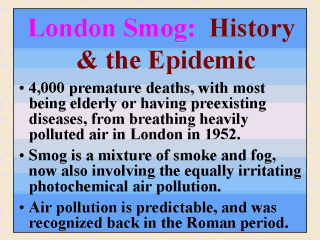| front |1 |2 |3 |4 |5 |6 |7 |8 |9 |10 |11 |12 |13 |14 |15 |16 |17 |18 |19 |20 |21 |review |
 |
It had been
estimated that the infamous London smog of 1952, that lasting about a week from December 4
to 10, resulted in nearly 4,000 premature deaths. Most of these excess deaths were elderly
and those with preexisting cardiac and respiratory diseases, who apparently were unable to
cope with the added stress imposed by breathing heavily polluted air. As noted by Costa
and Amdur (1996), “It is ironic that 16 years earlier the prediction had been made that
if an incident like that in the Meuse Valley (in Belgium in 1930) occurred in London, some
3,200 deaths would result.” The term smog is now more commonly used to characterize the irritating photochemical air pollution caused by the effects of bright sunlight on chemicals in vehicle emissions (Hodgson et al., 1998). Initially it was referred to as the mixture of smoke (with particle diameter of 0.05 - 1.0 µm) and fog that provided such limited visibility as < 3 feet to the victims of the 1952 incident. According to Elsom (1996), such a limited visibility was in part a result of the vast amounts of suspended particulates and sulfur dioxide from millions of domestic chimneys serving inefficient coal-burning household fires, together with emissions from thousands of wasteful industrial plants being spewed into the foggy, stagnant atmosphere of the River Thames basin. The effects of poor quality of urban air were recognized as early as some 2,000 years ago, by the Roman philosopher Seneca, who wrote “As soon as I had gotten out of the heavy air of Rome . . ., I felt an alteration to my disposition.” (Miller and Miller, 1993, as cited by Costa and Amdur, 1996). |